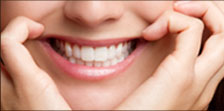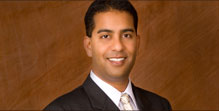Wesley Chapel Dentistry
28965 Wesley Chapel Blvd
Wesley Chapel, FL 33543

Patient Newsletter
Air Abrasion
October 22nd 2015
Rare is the person who goes through life without a single cavity. (If you know any people this fortunate, we would love to meet them!) Of course, a cavity means a filling, and a filling means—you guessed it—a drill. Or maybe not. Today, we can use air abrasion to remove decay and portions of tooth structure to prepare your tooth for a filling.
A cavity is the result of tooth decay, and tooth decay is caused by bacteria that live naturally in our mouths. If not removed with regular brushing and flossing, then bacteria can multiply. As they feed off of the sugars in many foods, they produce acids that erode tooth enamel. After a certain amount of erosion, a hole develops in your tooth and that’s a cavity.
Before the cavity can be filled, we need to remove the decayed material that has accumulated, as well as some of your natural tooth structure in order to make room for the filling. Traditionally, this removal was performed by a small drill. You may be familiar with this device and the high-pitched noise and vibration it generates. Not exactly a favorite of our patients.
Air abrasion, on the other hand, removes debris and tooth structure with minuscule bits if aluminum oxide or silica that are forcefully directed at your tooth. Imagine a small sandblaster, if you will. Similarly, air abrasion removes decayed material. We use compressed air to blast these particles at your cavity. As air abrasion is performed, we suction away the waste. Once this process is complete, we can go ahead and fill your cavity with a tooth-colored filling.
The Advantages of Air Abrasion
The most obvious advantage of air abrasion is that it is a much more pleasant way for us to remove decay than is a traditional drill. This process allows us to remove less of your original tooth structure. As conservative dentists, we prefer to retain as much natural tooth structure as possible. Doing so leaves you with a stronger and more durable tooth after the cavity is filled.
In addition, because we remove less tooth structure with air abrasion, you may not require anesthesia for every cavity we treat. Surface cavities can often be prepared without a local anesthetic if we are using air abrasion.
Of course, there are instances when a traditional drill is necessary, such as when we need to prepare your tooth for a porcelain crown, treating a cavity that is deep inside a tooth or when performing a root canal treatment. Otherwise, air abrasion may be the ideal solution for preparing your tooth for dental treatment.
What Can We Learn About Dental Care from Plaque?
September 29th 2015
 What many dentists know is that plaque is a biofilm, a combination of bacteria (500+ types), fungi, and protozoa, that mixes with nutrients from foods and drinks in the mouth to create a self-sustaining ecosystem. When plaque builds up near the gum line, it creates wounds that are the start of periodontal (gum) disease. What many dentists don’t know is that there are lessons to be learned about dentistry from the vitality of biofilm colonies: treatment should be specialized, treatment should be multidisciplinary, and treatment should be ongoing.
What many dentists know is that plaque is a biofilm, a combination of bacteria (500+ types), fungi, and protozoa, that mixes with nutrients from foods and drinks in the mouth to create a self-sustaining ecosystem. When plaque builds up near the gum line, it creates wounds that are the start of periodontal (gum) disease. What many dentists don’t know is that there are lessons to be learned about dentistry from the vitality of biofilm colonies: treatment should be specialized, treatment should be multidisciplinary, and treatment should be ongoing.
Biofilm Communities Teach us About Individualized Care
Most of the historical treatment of gum disease and other bacterial infections has been based on viewing individual bacteria cultures, and treating with antibiotics. What this research and treatment fails to take into account is that free floating single bacteria lead to acute illnesses, but do not typically cause wounds and chronic infections. Bacteria that combine to form protective biofilms are the cause of tooth decay, gum disease, and other chronic illnesses. Plaque buildup in the mouth is one specific form of biofilm that creates wounds that lead to periodontal disease. When gum disease is treated with generic antibiotics not only is this treatment less effective, it can also be detrimental to health as bacteria build stronger resistance to antibiotics. The solution? Personalized treatment. As every biofilm is made up of a unique combination of bacteria and other materials, cases of periodontal infection should receive unique care to remove and prevent future plaque buildup. There should never be a one-size-fits-all approach to dental care, and that goes for plaque wounds and infections.
Periodontal Disease Provides Lessons on Multidisciplinarity
Plaque builds strong defensive systems because more than 500 types of bacteria work together to fortify and protect the colony. Each type of bacteria has its own defensive system, and the more types of bacteria work together, the harder they are to remove. Dentists could learn a lesson from this defensive system. It’s time to break down the silos of medical care, and start working with dental specialist and other medical practitioners to better understand not just how to treat gum disease, but how to protect against it in the first place. Every field of dental and medical care has its own defenses against and treatments for infection, and there is much to be learned by sharing knowledge.
Treatment Changes & Community Building
Dr. Randy Wolcott, a wound care researcher, discovered that many patients treated for infection would relapse. Antibiotics or other therapies removed the initial disease, but did little to treat damaged tissue or prevent future infection. The future of periodontal therapy should take into consideration not only the removal of plaque and bacteria, but actually healing the wounds and preventing recontamination. Most patients who suffer from gum disease relapse numerous times necessitating additional treatment. With the dental community’s shift in focus to preventive care, it makes sense to include treatments to prevent gum disease. Some of the many treatments that protect against future infection include: the application of liquid medications with dental trays worn at home, ozone therapy (shown to improve tissue healing and prevent future infection), and more traditional root planing.
Going Forward
The lessons learned from this surprising source are beneficial for any practice and any dental health concern. It’s time to start taking into consideration unique needs, shared knowledge, and ongoing prevention every time we care for patients.
Do Nice Dentists Finish Last? – Do Dentists Have to be Cruel to be Kind?
August 19th 2015
 Ever heard the phrase, “you’ve gotta be cruel to be kind?” It has never been truer than when referring to gum disease treatments. Periodontal disease affects as much as 80% of US adults, but the way dental practitioners handle periodontal treatments may be part of the problem. Patients avoid periodontal treatment due to lack of treatment urgency, not fully understanding necessary treatments, and money. Many dentists hesitate to fully explain and recommend periodontal therapy because they fear patients will simply cancel appointments due to the added cost. Instead, dentists tend to try the “nice” approach – recommending periodontal appointments every three months but billing them as regular dental cleanings during six month checkups. However, by changing the focus of periodontal disease treatment to communicating clearly, emphasizing assessment and prevention, and working with patients to maximize insurance benefits, dentists can better equip patients to receive the dental care they need.
Ever heard the phrase, “you’ve gotta be cruel to be kind?” It has never been truer than when referring to gum disease treatments. Periodontal disease affects as much as 80% of US adults, but the way dental practitioners handle periodontal treatments may be part of the problem. Patients avoid periodontal treatment due to lack of treatment urgency, not fully understanding necessary treatments, and money. Many dentists hesitate to fully explain and recommend periodontal therapy because they fear patients will simply cancel appointments due to the added cost. Instead, dentists tend to try the “nice” approach – recommending periodontal appointments every three months but billing them as regular dental cleanings during six month checkups. However, by changing the focus of periodontal disease treatment to communicating clearly, emphasizing assessment and prevention, and working with patients to maximize insurance benefits, dentists can better equip patients to receive the dental care they need.
Say What You Mean – To Be Unclear is to be Unkind
Gum disease is caused by a buildup of plaque around or below the gum line. These plaque deposits harden into tartar which can irritate gum tissue leading to gingivitis. This is a mild form of gum disease that is easily treated at your regular dental checkups. However, left untreated, gingivitis can develop into periodontitis. This more advanced form of periodontal disease is detrimental to oral and whole body health.
To be clear: periodontal disease is dangerous! Studies have linked advanced gum disease to chronic and systemic illnesses such as cardiovascular disease, diabetes, and preterm or low weight births, it effects more than half of the US adult population, and is the leading cause of tooth loss. Not treating periodontal disease is not an option. There is good news about gum disease. It is 100% treatable and preventable, and your dentist is always here to help you do both.
Learned Behaviors – You Have to be Good to be Lucky
The best way to treat gum disease is avoid having it in the first place. With proper at home hygiene and regular, biennial dental visits, you’ll be on your way to a healthy smile for life. At regular dental appointments, your dentist should screen for signs of periodontal disease, and make sure that plaque and tartar have been removed during your teeth cleaning.
If you do have advanced gum disease, you’ll need more advanced treatment. Typically antibiotics are recommended in addition to scaling (removal of excessive tartar buildup below gum line) and root planing (smoothing of the root making it more difficult for plaque to attach to the tooth’s surface). For the most severe cases, laser or surgical treatments may be necessary, and are typically performed by a periodontist.
Financial Preparedness – Your Smile is Worth its Weight in Gold
As the number of people with periodontal disease increases, more insurance providers are beginning to cover the appropriate treatment. However, make sure you speak with your dentist or the practice’s financial coordinator about maximizing the benefits of your insurance coverage in order to obtain the necessary treatment. If your insurance doesn’t cover the recommended care, talk to your dentist about alternatives that won’t compromise your treatment, or consider working with a third part healthcare financier like CareCredit.
Periodontal Therapy – You’re Only as Good as Your Last Shift
Gum disease is episodic. That means that patients can go years being asymptomatic before the disease comes back. Regular maintenance and assessment from a skilled dental practitioner twice a year is the only way to ensure your dental health for a lifetime.
Ditch The Smoking Habit for Excellent Oral Health
July 25th 2015
 There are a lot of tobacco users in this country. Whether it’s smoking, dipping, or any other kind of activity, tobacco can leave your mouth, and especially your smile, worse off. Think about it. There are countless carcinogens inside of a single cigarette that can have devastating effects on the appearance of your teeth. Yellow teeth are most often associated with smoking, but your tongue can turn yellow as well. It isn’t just the appearance of your teeth that should be important, your overall health is put into question with each puff. Oral cancer and other ailments are widely associated with tobacco use and for good reason. Gum disease and other ailments can also increase in size and scope when you smoke or dip. Do yourself a favor: stop.
There are a lot of tobacco users in this country. Whether it’s smoking, dipping, or any other kind of activity, tobacco can leave your mouth, and especially your smile, worse off. Think about it. There are countless carcinogens inside of a single cigarette that can have devastating effects on the appearance of your teeth. Yellow teeth are most often associated with smoking, but your tongue can turn yellow as well. It isn’t just the appearance of your teeth that should be important, your overall health is put into question with each puff. Oral cancer and other ailments are widely associated with tobacco use and for good reason. Gum disease and other ailments can also increase in size and scope when you smoke or dip. Do yourself a favor: stop.
Oral cancer: According to the American Cancer Society, roughly 90% of patients with oral cancer have partaken in tobacco use of some kind. Did you know smokers are six times more likely to develop oral cancer than non-smokers? Simply put, the longer you use tobacco, the greater your risk for oral cancer.
Gum disease: Tobacco doesn’t just do a number on your teeth, your gums are also caught in the crosshairs. Periodontal disease, or gum disease as it’s more commonly known, accounts for almost 50% of smoking-related diseases. That’s an astronomical number. The only way to combat it is through surgical and nonsurgical treatment.
There’s no such thing as a “safe” tobacco. All tobacco is bad for your oral health, period. There are certain steps you can take to avoid oral cancer or periodontal disease, or both. All it takes is dedication and the willingness to be proactive about your oral and overall health.
- Quit smoking. It’s that easy. Your risk of oral health problems is dramatically decreased. The longer you don’t have a puff, your risks are practically depleted.
- Go to your dentist regularly. Getting a regular dental checkup can work wonders for your oral health. He or she can detect oral cancer if any symptoms are present.
- Practice proper brushing and flossing techniques. Since tobacco has so many harmful carcinogens, it can leave your gums overheated. Brushing and flossing thoroughly can help combat against oral cancer and helps you maintain great dental health.
It’s never too late to kick the smoking habit. Your oral health is a huge concern when it comes to tobacco use. Don’t battle oral cancer or other ailments later on in life. Keep your mouth as healthy as it can possibly be – kick cigarettes, dip and other tobacco products to the curb.
Heed These Helpful Dental Tips Before the Kids Are Back In School
June 20th 2015
 Your kids have been out of school for a couple months now, but before you know it it’ll be time to ease them into the back-to-school routine. Lost in all the fracas is the time necessary to receive a regular checkup. You were a kid once, what did you do during the summer? You most likely spent your days outdoors with friends getting into trouble and doing who knows what. Now that you’re older, you should understand the importance of a dental checkup, especially for your kids. Who knows what kinds of sugary treats and other goodies they’ve been gorging on for the past couple months. A dental checkup can check for problems and help keep their mouths healthy throughout the school year.
Your kids have been out of school for a couple months now, but before you know it it’ll be time to ease them into the back-to-school routine. Lost in all the fracas is the time necessary to receive a regular checkup. You were a kid once, what did you do during the summer? You most likely spent your days outdoors with friends getting into trouble and doing who knows what. Now that you’re older, you should understand the importance of a dental checkup, especially for your kids. Who knows what kinds of sugary treats and other goodies they’ve been gorging on for the past couple months. A dental checkup can check for problems and help keep their mouths healthy throughout the school year.
The best way to keep your little one on the road to optimal oral health, is by compiling a back-to-school checklist. This is a great way to keep your children’s oral health in check. What all should be included on this checklist? Here are some friendly tips to help you get started:
- Take them to regular dental examinations. Unless you’re a licensed dentist, you won’t be able to tell whether or not your child has an infection or disease inside their mouth. Some symptoms never show at all. Your dentist is the only one who can properly diagnose and eradicate bacteria or an infection. It saves your child future pain and doesn’t keep them away from the classroom.
- Help them practice excellent dental hygiene. There’s a lot more to brushing and flossing than meets the eye. It is entirely possible to practice incorrect brushing and flossing techniques, and in order to keep their mouths happy and healthy, you may need to show them how it’s done. There are countless online resources for guidance, or, just give your dental office a call.
- Pack healthy lunches. Ditch sugary treats for healthy options like grains, milk, yogurt, fruit and raw vegetables. Not only do they keep teeth healthy, but they have whitening benefits as well. Fruit, like strawberries and oranges, help teeth naturally whiten.
- Protect their mouths during sporting activities. Mouthguards are designed to keep your teeth in place and away from danger. They’re especially useful for organized sports, playing on the playground, or physical education classes.
Ensure your kids’ mouths are in great shape by being proactive and making an end-of-summer checklist. Send them back to school with smiles that are sure to turn them into teacher’s pets.














